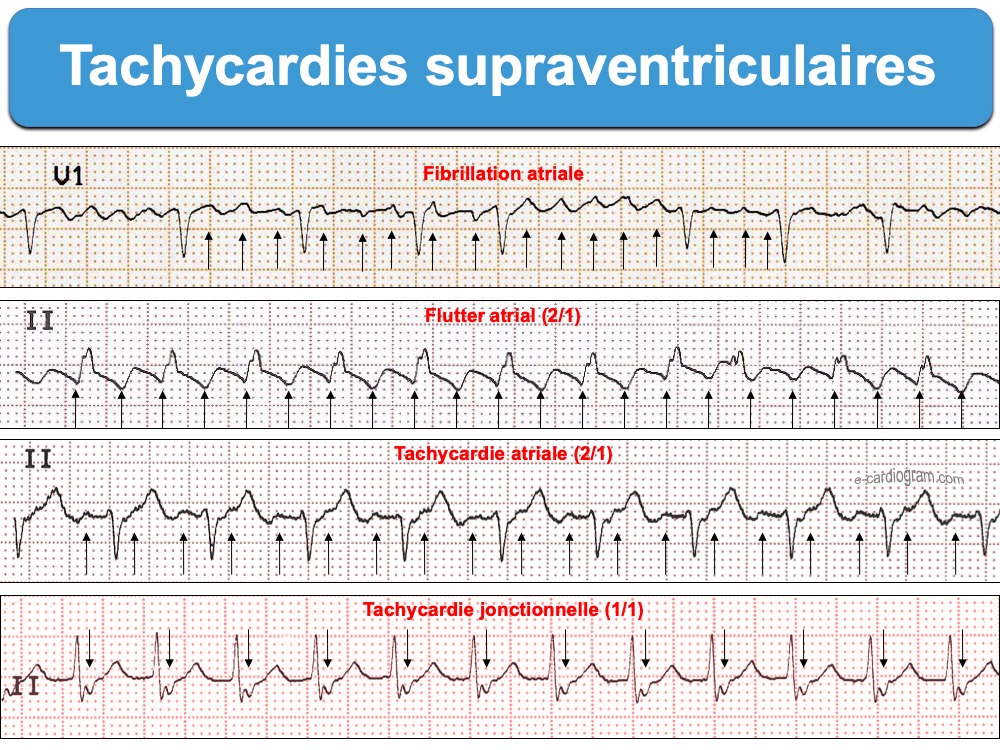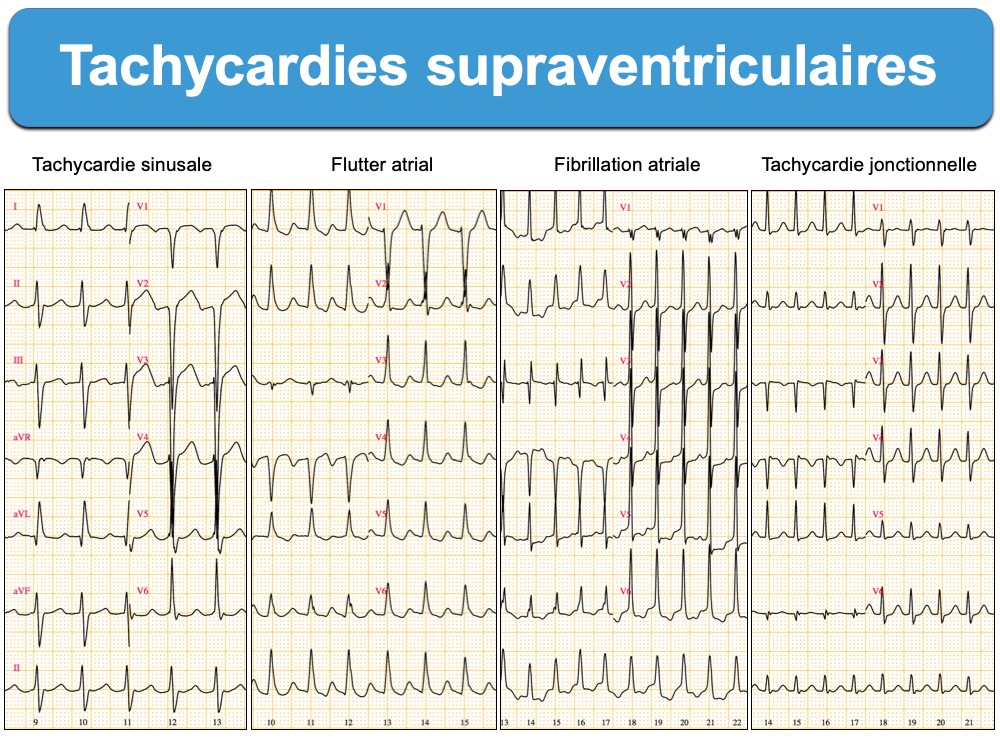Ensemble des tachycardies qui naissent au-dessus de la bifurcation du faisceau de His et ont besoin de l’oreillette, du nœud AV ou des deux pour leur initiation ou leur persistance (AHA 2015 [1] et ESC 2019 [2]).
La dénomination repose sur le siège, le circuit emprunté et le mécanisme physiopathologique de l’arythmie (voir super schémas [3]). Les tachycardies atriales (fibrillation atriale, flutter et TAF) sont plus fréquentes que les arythmies atrioventriculaires (ex. tachycardies par réentrée intranodale ou tachycardies par réentrée AV via un faisceau accessoire). Ces dernières sont paroxystiques (à mode début initial et final brutal), surviennent chez des patients plus jeunes avec cœur sain et leurs fréquences sont plus rapides.
Le terme “TSV” (tachycardie supraventriculaire) s’utilise dans le langage courant en présence d’une tachycardie régulière dont l’identification précise est malaisée sur un ou plusieurs tracés consécutifs et qu’il y a volonté d’écarter une tachycardie sinusale, une fibrillation atriale ou une tachycardie ventriculaire. Il inclut donc, dans ce cas, des TSV régulières à QRS fins mais aussi larges, c’est à dire essentiellement les arythmies atrioventriculaires, les TA focales et les flutters atriaux. La prévalence des TSV paroxystiques dans la population générale est mal connue [2].
Classification ESC 2019 [2]
Tachycardie sinusale
- Physiologique (Cf. Tachycardie sinusale)
- Inappropriée (Cf. Tachycardie sinusale inappropriée)
Tachycardies atriales
- Fibrillation atriale (non inclue classiquement dans les TSV)
- Flutter atrial
- typique (horaire ou antihoraire)
- atypique
- Tachycardie atriale focale ou TAF (automatique, réentrée, auto-déclenchée)
- Tachycardie atriale multifocale ou TAM (cf. Rythme atrial multifocal)
Arythmies atrioventriculaires
- Tachycardies par réentrée intranodale ou TRIN dites “tachycardies jonctionnelles” (Cf. Tachycardie nodale)
- typique (slow-fast)
- atypique (fast-slow) [4]
- Tachycardies par réentrée AV ou TRAV (Cf. Syndrome de WPW, Tachycardies de Mahaïm)
- orthodromique
- antidromique
- permanente ou TJRP (Cf. Tachycardie jonctionnelle réciproque permanente)
- Tachycardie jonctionnelle non réentrante ou TJ ectopique ou JET (cf. TJ non réentrante)
Classification TSV (ESC 2019) [1]
11.1Atrial arrhythmias . . . . . . . . . . . . . . . . . . . . . . . . . . . . . . . . . . . . . . . . . . 19
11.1.1 Sinus tachycardia . . . .. . . . . . . . . . . . . . . . . . . . . . . . . . . . . . … 20
11.1.2 Focal atrial tachycardia . . . . . . . . . . . . . . . . . . . . . . . . . . . . . . .21
11.1.3 Multifocal atrial tachycardia . . . . . . . . . . . . . . . . . . . . . . . . . . .24
Atrial Fibrillation (non traitée)
11.1.4 Macro-re-entrant atrial tachycardias . . . . . . . . . . . . . . . . . . . 24
11.1.4.1 Cavotricuspid isthmus-dependent macro-re-entrant atrial tachycardia . . . . . . 24
11.1.4.1.1 Typical atrial flutter: common (counter-clockwise) and reverse (clockwise) . 24
11.1.4.1.7 Other cavotricuspid isthmus-dependent macro-re-entrant atrial tachycardia 27
11.1.4.2 Non-cavotricuspid isthmus-dependent macro-re-entrant atrial tachycardia . . . 27
11.2 Atrioventricular junctional arrhythmias . . . . . . . . . . . . . . . . . .. . . . . 29
11.2.1 Atrioventricular nodal re-entrant tachycardia . . . . . . . . . . . 29
11.2.1.1.3 Typical atrioventricular nodal re-entrant tachycardia . .30
11.2.1.1.4 Atypical atrioventricular nodal re-entrant tachycardia .30
11.2.2 Non-re-entrant junctional tachycardias . . . . . . . . . . . . . . . . 32
11.3 Atrioventricular arrhythmias . . . . . . . . . . . . . . . . . . . . . . . . . . . . . . . . 32
11.3.1Accessory pathways . . . . . . . . . . . . . . . . . . . . . . . . . . . . . . . . . .32
11.3.2WolffParkinsonWhite syndrome . . . . . . . . . . . . . . . . . . . . . . .33
11.3.3 Orthodromic atrioventricular re-entrant tachycardia . . . . . 33
11.3.4 Antidromic atrioventricular re-entrant tachycardia . . . . . . 34
11.3.5Accessory pathway as a bystander . . . . . . . . . . . . . . . . . . . . . 34
11.3.6 Pre-excited atrial fibrillation . . . . . . . . . . . . . . . . . . . . . . . . . . 34
11.3.7Concealed accessory pathways . . . . . . . . . . . . . . . . . . . . . . . . . 34
11.3.8 Permanent junctional reciprocating tachycardia . . . . . . . . . .35
11.3.9Atypical forms of pre-excitation . . . . . . . . . . . . . . . . . . . . . . . . 35
Vidéos YouTube (P. Taboulet)
- Diagnostic des tachycardies supraventriculaires aux urgences (2019)
- Vidéo cours 3 (73 min). Anomalie de l’automatisme et tachycardies supraventriculaires
S.W Smith’s blog
- Supraventricular Tachycardias (including ED management of atrial fibrillation) : one hour lecture
- You can get fooled if you don’t read the ECG systematically
Magnifique mise au point (2006 et 2012) : évaluation et traitement initial avec schémas [3][4]
Epidémiologie et et taux d’hospitalisation en Suède (super) [6]
Recommandations ACC/AHA; EHRA 2015; ESC 2019 et nombreuses autres références utiles (abonnés)
La suite est réservée aux membres et stagiaires du site.
Connexion | Devenir membre | Devenir stagiaire



